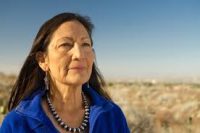Native American Heritage Month creates cultural pride

Deb Haaland, of Native American heritage, ran for Congress in 2018 representing New Mexico.
January 3, 2020
Native Americans are often disregarded for their role in American history. Native American Heritage Month takes place in Nov. every year and is an important time to remember the lives and culture on which the foundations of America were laid out upon.
For most Americans, the first event taught in relation to Native Americans is Thanksgiving: a joyous holiday of cultural unity and a bountiful harvest. Squanto, an English speaking Native, helped the starving pilgrims and eased the tension between the two peoples. However, this event and the ideas of peace that stemmed from it, hides the aftermath of colonialism for Native Americans.
“It is difficult for most Americans to think of the Thanksgiving holiday as being ‘controversial’,” AP US History teacher Eric Imperial said. “But the story of Thanksgiving that is taught in schools – that the Native Americans welcomed the Pilgrims for a festive gathering after helping them adapt to a new life in America – is a complete fiction. At that time, the Wampanoags were searching for a way to deal with the external threat from other Native America tribes and the devastating impact of the epidemic diseases brought by the Pilgrims.”
Native American history can be traced back much further than their interactions with European colonists, all the way to the original Eurasian settlers who crossed the Bering Strait to America. They developed complex hierarchies, agricultural knowledge and complex cultures while isolated from the Eastern Hemisphere; they lived in relative prosperity.
Once the Spanish, British, French and Portuguese began conquering land in the newly discovered Americas, native populations were wiped out due to their lack of gunpowder based weaponry and lack of immunity to European diseases. In the early years of America, Andrew Jackson’s Trail of Tears, George Washington’s “civilizing process” and Manifest Destiny continued to threaten the land, culture and society of Native Americans.
“Learning about Native American history will reveal a very tragic aspect of our past,” Gary Scholl, a Native American studies teacher in John Carroll School in Bel Air, Md. said. “Indian people were seen as uncivilized tribal societies that stood in the way of the growth and progress of America. They were treated as enemies whose ways of living had no value. Today we have new challenges arising from our diversity, and from immigration. We have the opportunity to avoid the mistakes of our past.”
Despite brief mentions of Native Americans in early US history classes, these do not truly detail the magnitude of diversity of each tribe, the complexity of each society or their deep impacts on America.
“It’s important to teach about Native American history as part of our larger, shared, American history,” Renee Gokey, Eastern Shawnee and the Student & Teacher Services Coordinator of the Smithsonian’s National Museum of the American Indian said. “Oftentimes, Native American History can be put on the ‘fringes’ and is relegated to a few paragraphs in textbooks”
There is also much to learn from the beliefs of Native Americans, known for their deep connection to nature and credence for respect.
“The Cheyenne historically have emphasized harmony with all of creation,” Scholl said. “As modern humans cause more and more damage to our planet, this is an approach that is needed because it is right and because it is crucial to our survival as a species. How different our world would be today if we saw everything as sacred, and everything we did or said was seen in part as a prayer.”
Although there is a much greater awareness of the need to respect other cultures and right the wrongs of America’s past, discrimination still exists as seen by President Trump’s purposeful choice to celebrate European colonists over Native Americans with his proclamation of National American History and Founders Month. American politics, media and education curriculums tend to limit indigenous peoples’ narrative to one of poverty or social disparities and have created the image of an undeveloped society and culture that exists only on reservations.
But Native Americans have always been and are becoming more prominent in American culture and politics, as seen by the record number of indigenous people running for office every year, upwards of 100 politicians, with the first indigenous women being elected to Congress in 2018.
According to the National Museum of the American Indian, 70% live in urban areas rather than reservations. 60% of our world’s food is indigenous to the Americas. Native Americans are just as much a part of America as any other ethnicity and should no longer be excluded in national discussion.
Americans can help continue remembering the tragedies of Native American treatment in the past and celebrate the current culture/traditions by attending Pow wows (Native American social gatherings), reading books or historical accounts from Native Americans, visiting the National Museum of the American Indian in DC, visiting a Native American reservation or preparing traditional Native American meals.
“There are many Native American traditions that are open to non-Indian people. Some are social and some are ceremonial,” Scholl said. “The key to involvement is to be informed about the traditions and the appropriate role for visitors. The key is to be respectful and to ask for guidance on the appropriate ways of involvement.”
Especially in Maryland where Washington DC, a hub of diversity in cultural education, is nearby, there are many ways for people to become involved.
“Attend an art exhibit, for example an upcoming show at the Renwick Gallery in DC called the Hearts of Our People showcases Indigenous women artists,” Gokey said. “Eat Indigenous food (60% of our world’s food is Indigenous to the Americas!) and learn more about the origins and history of that food and the traditions that Native people still have with wild rice, chocolate, corn or salmon. Native people have always innovated and we are a modern people.”

